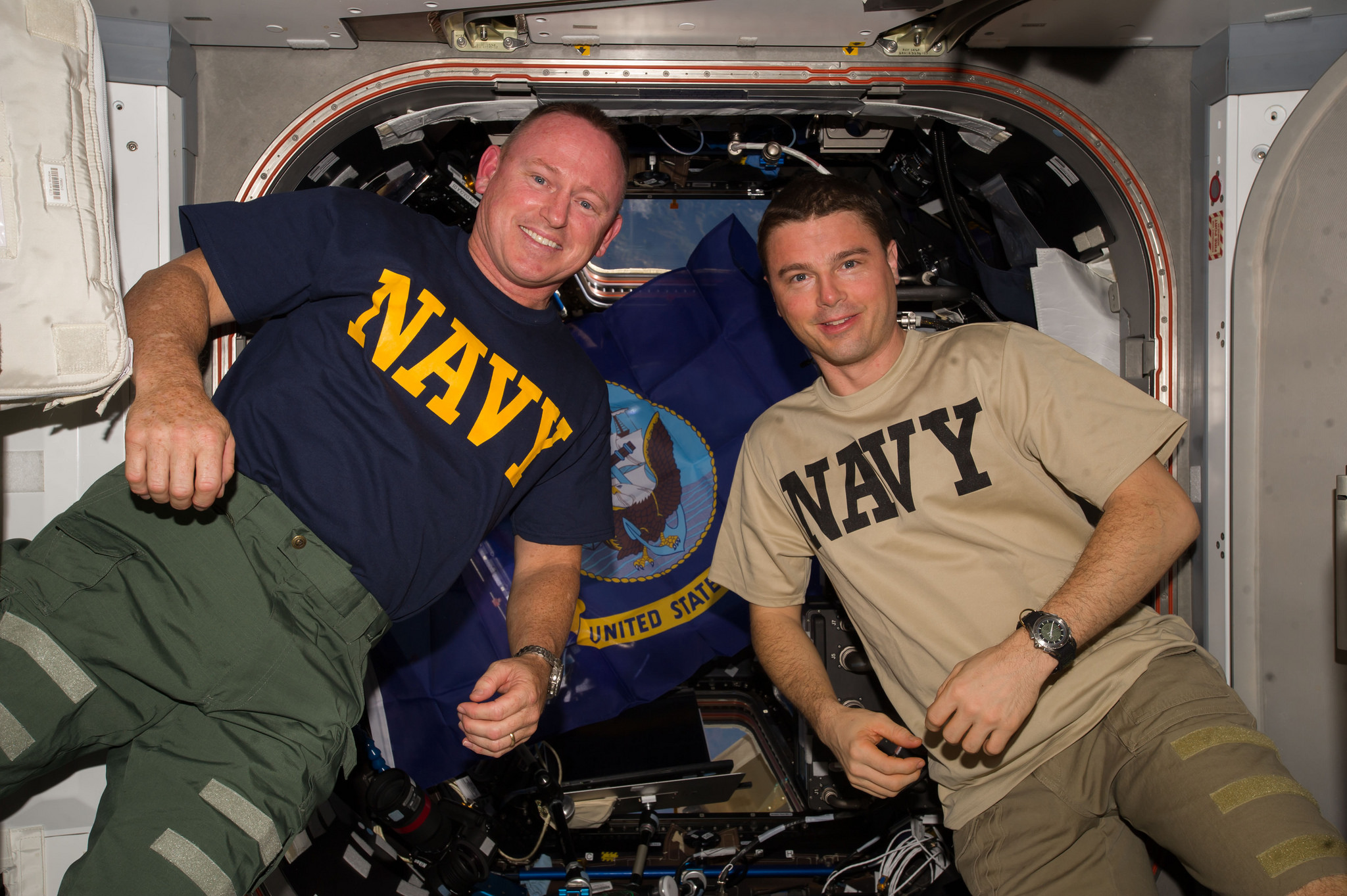
Just eight days after EVA-27, U.S. spacewalkers will again depart the Quest airlock tomorrow (Wednesday, 15 October) to install a replacement Sequential Shunt Unit (SSU) onto the starboard truss of the International Space Station (ISS) and remove and relocate cameras and other equipment in anticipation of next year’s movement of the Leonardo Permanent Multipurpose Module (PMM) and the arrival of Commercial Crew vehicles from 2017 onward. Expedition 41 astronauts Reid Wiseman (designated “EV1,” with red stripes on the legs of his space suit for identification) and Barry “Butch” Wilmore (“EV2,” wearing a pure-white suit) are expected to leave Quest at about 8:15 a.m. EDT, and their tasks should require approximately 6.5 hours. Both men represent the U.S. Navy—Wiseman is a commander, Wilmore a captain—and this will be the first all-Navy U.S. EVA since the spacewalks of Heidemarie Stefanyshyn-Piper and Steve Bowen on shuttle mission STS-126 in November 2008.
Final preparations for EVA-28 will begin in the small hours of Wednesday morning, when Wiseman and Wilmore jump onto a well-trodden path of 60 minutes of “pre-breathing” on masks, during which time the airlock’s inner “equipment lock” will be depressed from its ambient 14.7 psi down to 10.2 psi. This pre-breathing protocol should conclude at about 4:30 a.m. Assisted by Expedition 41 comrade Alexander Gerst of the European Space Agency (ESA)—who last week became Germany’s third spacewalker and who will serve as “Intravehicular” (IV) crewman during EVA-28—Wiseman and Wilmore will don and purge their bulky Extravehicular Mobility Unit (EMU) space suits at about 5:45 a.m. The Quest airlock’s atmosphere will then be repressurized to 14.7 psi.
The spacewalkers will then enter a nominal pre-breathing regime, lasting about 50 minutes, followed by another 50 minutes of In-Suit Light Exercise (ISLE). The latter was first trialed on the STS-134 shuttle mission in May 2011 and will involve Wiseman and Wilmore flexing their knees for about four minutes, resting for one minutes, then repeating over and over until the 50 minutes are up. This technique serves to remove nitrogen from their bloodstreams in a much shorter timeframe than was previously possible.
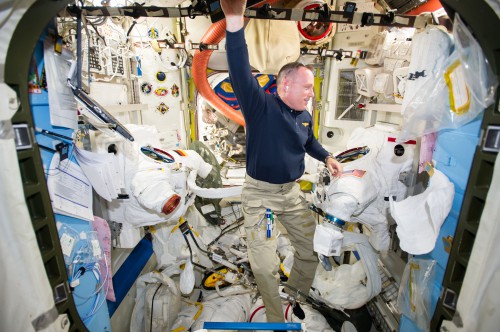
At about 7:30 a.m., the fully-suited pair and their equipment—including the Simplified Aid for EVA Rescue (SAFER) units, affixed to the lower section of their life-sustaining backpacks—will be transferred by Gerst from the equipment lock into Quest’s outer “crew lock.” Hatches between the two locks will be closed and depressurization should get underway shortly before 7:45 a.m., reaching the 5 psi “hold point” for leak checks shortly thereafter. Assuming all goes well, the depressurization process will continue until the crew lock reaches a condition of near-vacuum, and EVA-28 will officially commence at about 8:15 a.m., when Wiseman and Wilmore transfer their suit’s critical life-support utilities onto internal battery power.
Pushing open the outer hatch, Wiseman will depart the airlock first, followed by Wilmore, who will bring out the spare SSU in an Orbital Replacement Unit (ORU) bag. Provided by Space Systems/Loral (SS/L), there are eight SSUs on the space station, which are responsible for regulating the incoming power from the eight Solar Array Wings (SAW) at an established “set point” of 160 volts, by shunting and unshunting 82 separate array “strings,” to ensure a steady output across the ISS. Weighing 186 pounds (84 kg), each SSU can handle 38.5 kW of electrical power at an efficiency of 98.5 percent.
On 8 May 2014, the station lost its “3A” power channel, when the controlling SSU experienced an internal electrical short. Loads were immediately transferred to the 3B channel, with minimal loss of power, although the Optical Payload for Lasercomm Science (OPALS) and the Alpha Magnetic Spectrometer (AMS)-2 suffered from a temporary suspension of operations. The failure “was associated with a sharp temperature increase … and a high current difference between the two SSU circuits that was six times higher than normal,” noted Spaceflight101 at the time. “These two indications point to a failure internal to the SSU that may not be recoverable by ground commanding.”
With the other seven power channels—1A, 1B, 2A, 2B, 3B, 4A, and 4B—classified as fully functional, the ISS remained in a safe configuration, although the replacement of the failed SSU was important to hedge against the risk of future failures. Originally, this replacement task was planned for August 2014, during Expedition 40, although it was delayed until October and the early stages of Expedition 41 in the wake of problems with Long Life Batteries (LLBs) in the U.S. space suits.
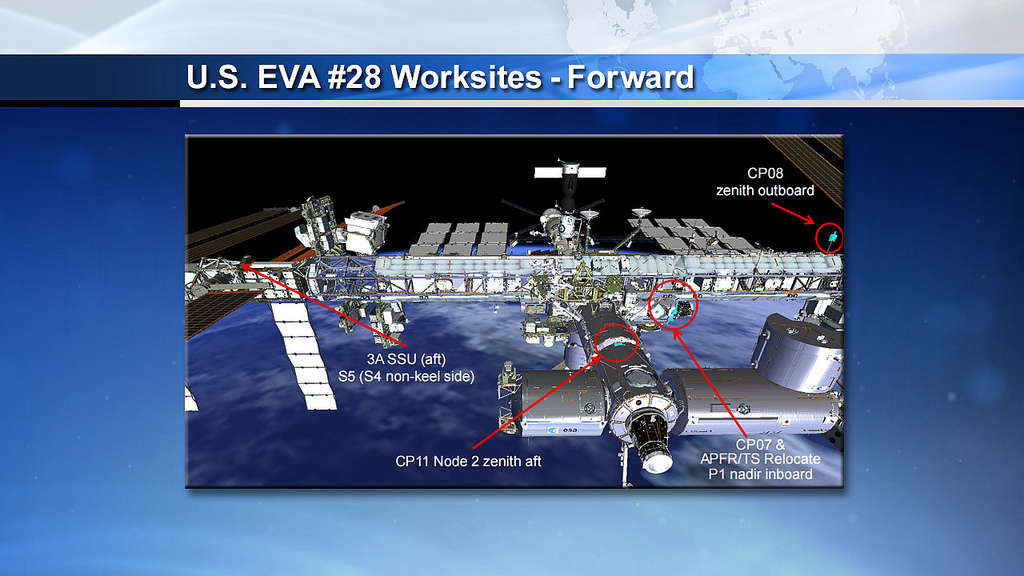
After closing the thermal cover of the Quest airlock, Wiseman and Wilmore will press immediately into critical “buddy checks” of each other’s suits and safety tethers. They will then separate and head for their first work site. Wiseman—making his second career spacewalk, following last week’s EVA-27—will assist his first-time crewmate in moving along the Crew and Equipment Translation Aid (CETA) “spur.” Wilmore will also be the first former shuttle pilot to embark on an EVA since Ken Bowersox on Expedition 6 in April 2003, just a few months after the Columbia disaster. Wilmore will start out first along Face 1 of the S-1 starboard truss segment, dropping the Green Hook from his tether bundle to enable him to safely venture further outboard along the expansive truss structure.
Meanwhile, Wiseman will climb up to the Starboard CETA Cart and transfer his crew lock bag, containing his tools, onto an Articulating Portable Foot Restraint (APFR). He will then release the bag/APFR “bundle” and attach it to his Body Restraint Tether (BRT). The latter was first tested aboard the shuttle in the mid-1990s and is designed to hold a spacewalker steady, whilst clamped to a handrail, and carries the benefit of freeing the hands to perform useful work. Serving as a “third hand,” the BRT consists of a stack of balls, connected through the center by a cable, with a clamp on one end and a bayonet probe on the other to attach to Wiseman’s suit. He will be able to bend and twist the BRT to the appropriate position, then “lock” it in place with a knob which tightens the cable.
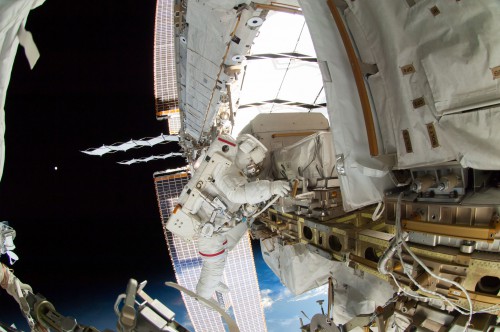
Carrying his tools, Wiseman will join Wilmore out on the S-1 truss, where he too will drop his Green Hook. The two men will then venture further outboard, past the S-3 Solar Alpha Rotary Joint (SARJ), until they reach the 3A solar array and the location of the SSU on the Beta Gimbal Platform, at the base of the Mast Canister Assembly. Wilmore will stow the ORU bag containing the replacement SSU onto the S-5 truss, whilst Wiseman will install the APFR and crew lock bag onto a Worksite Interface (WIF) socket. He will remove his tools and install them at the work site, then ingress the APFR.
Wiseman will lead the SSU replacement effort, first installing a handling aid (known as a “scoop”) onto the failed unit and loosening a bolt in readiness for driving it all the way out. Waiting for eclipse, Wiseman will then pull out the failed SSU, as Wilmore readies the replacement unit and hands it to his crewmate. Before installing it, Wiseman will present the “business end” of the SSU to Wilmore, so that checks of the electrical connectors can be made for any damage, bent pins, debris, or anything which might hamper its satisfactory installation. At length, Wiseman will rotate the SSU into position and drive the bolt, whilst Wilmore monitors alignment and motion. Following the installation, Mission Control will commence initial testing of the new unit.
Wiseman will remove the handling scoop and pass the failed SSU to Wilmore, who will stow it in the ORU bag and attach it to his own BRT. Meanwhile, Wiseman will egress the APFR and put both it and his crew lock bag onto his BRT. Inching their way along the truss, the spacewalkers will return inboard, picking up their Green Hooks, to complete the first task of EVA-28. Wiseman will stow the APFR and retrieve the crew lock bag, and Wilmore will return the failed SSU to the Quest airlock and pick up a small ORU bag for his next assignment. He will move to Camera Port (CP)-7 on the port-side P-1 truss and stow the ORU bag, with Wiseman joining him a little further port, in order to avoid conflicting their safety tethers. They will detach the APFR tool stanchion and move it further inboard, which will put it out of the way in time for the Leonardo PMM relocation, currently planned for July 2015.
Returning to CP-7, Wilmore will unbolt and remove the camera and hand it to Wiseman, who will temporarily stow it, as the astronauts tend to the disconnection of three electrical connectors and the movement of the stanchion. Carrying the stanchion on his BRT, Wilmore will then head to the space-facing “end” of the Harmony node (known as “zenith-aft”)—at the junction with the Destiny laboratory module—where the CP-11 camera group is situated. He will install the stanchion at CP-11 and mate the electrical connectors. Elsewhere, Wiseman will translate “port-zenith” to CP-8, where he will release three bolts of the Wireless Video System External Transceiver Assembly (WETA) and install a handling scoop. He will remove the WETA and attach it to his BRT, perhaps pausing to take in the spectacular view from the far-port side of the truss, which will give him an unhindered perspective of the entire Japanese segment of the ISS.
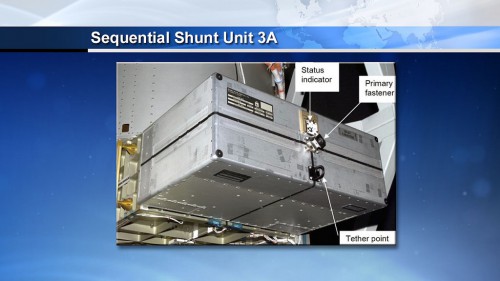
There will be little time to admire the view, however, for Wiseman must translate rapidly to rejoin Wilmore at CP-11 and hand over the WETA. As Wilmore works to install the WETA on the CP-11 stanchion, Wiseman will pick up the temporarily stowed CP-7 camera group and translate back to the airlock to exchange it with a replacement unit in a large ORU bag. He will then translate back to the port-side truss, up to CP-8, and install the new camera group to the stanchion, checking the alignment of the camera lens cover to ensure that it is square. Both spacewalkers will then push into “clean-up” tasks, stowing equipment into their ORU bags and attaching them to their BRTs. Current plans call for Wilmore to re-enter the airlock first, followed by Wiseman, after about six hours and 30 minutes.
Aside from the replacement of the failed SSU, EVA-28’s relocation of external cameras will prove critical for next year’s scheduled arrival of the first International Docking Adapters (IDAs) for the long-awaited Commercial Crew vehicles. According to Space Station Integration Operations Manager Kenny Todd, these EVAs mark the beginning of a salvo of spacewalks which will run into the spring and summer of 2015. Mr. Todd stressed that the two contingency EVAs last December and also a third unplanned spacewalk in April 2014 by Expedition 39’s Rick Mastracchio and Steve Swanson “had left some things out there that we knew we wanted put back in proper order.” He added that there was an urgent need to tend to power-related issues and improve the station’s fault-tolerant capability, ahead of several more complex EVAs next year.
Current plans call for two U.S. spacewalks in January 2015, two others in April and June and a further pair in August to route cables and utilities in support of the relocation of the Leonardo Permanent Multipurpose Module (PMM) and the Pressurized Mating Adapter (PMA)-3. This will lay the groundwork for the delivery of two International Docking Adapters (IDAs) in support of Boeing’s CST-100 and SpaceX’s Dragon V2 Commercial Crew vehicles. The Leonardo PMM will be robotically transferred in July 2015 from the nadir port of the Unity node to the forward port of the Tranquility node, whilst PMA-3 will be moved in the late August timeframe from its current berth on Tranquility to the zenith port of the Harmony node for Commercial Crew operations.
Want to keep up-to-date with all things space? Be sure to “Like” AmericaSpace on Facebook and follow us on Twitter: @AmericaSpace



